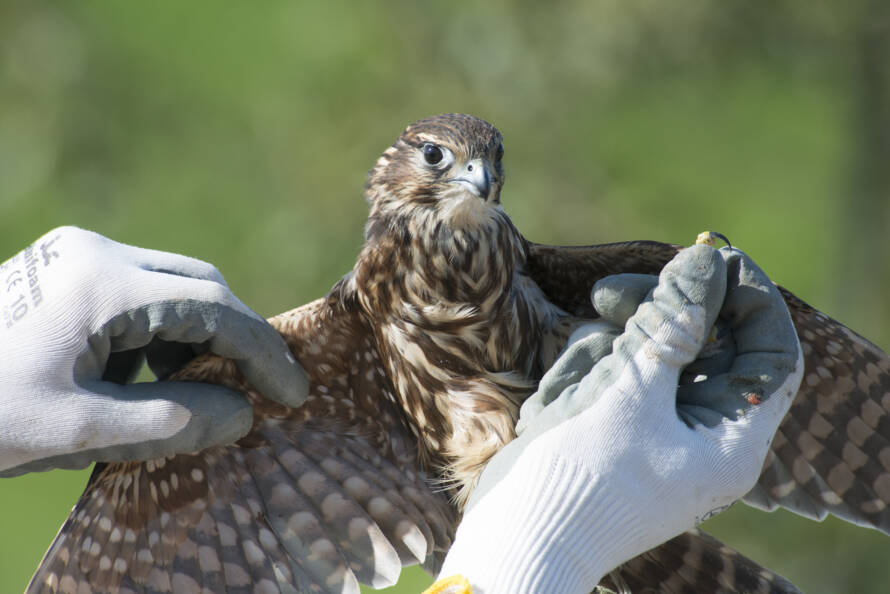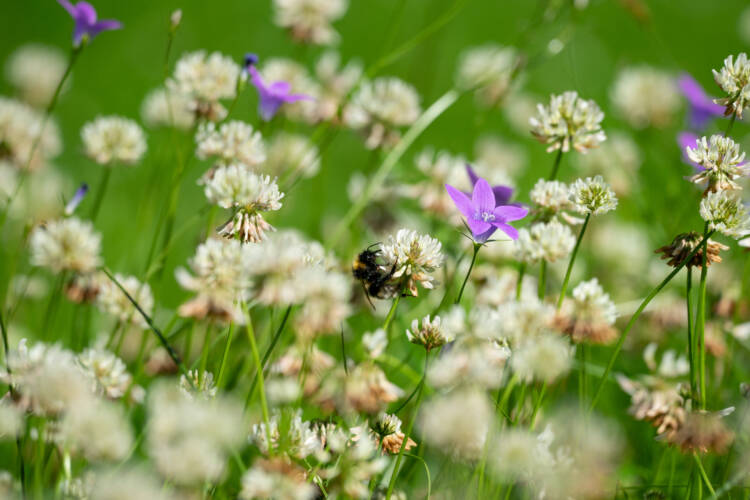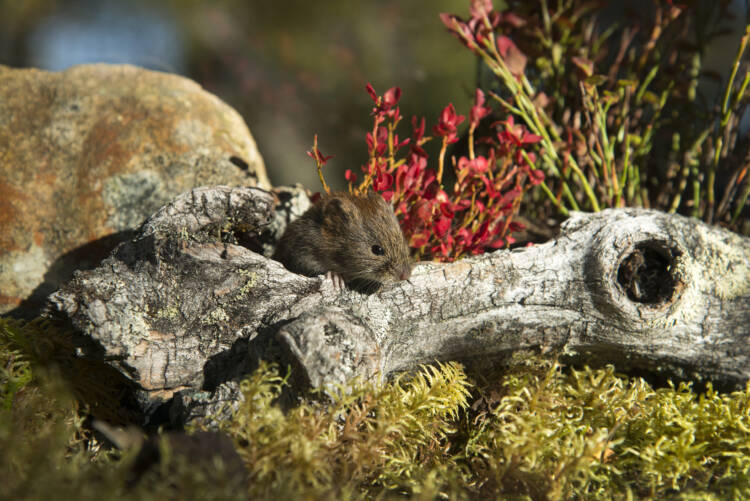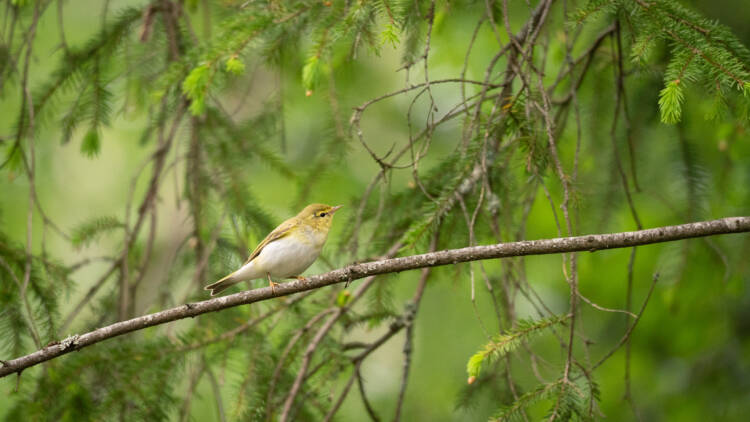Species monitoring
The goal of species monitoring is to observe changes in the population sizes, densities, distribution ranges, or compositions of species communities. Based on monitoring data, it is possible to assess the overall status and trends of biodiversity.

On this page:
- Species monitoring
- Types of species monitoring
- Monitoring data coordinators and other actors producing monitoring data
- Active species monitoring schemes
Species monitoring
The aim of species monitoring is to observe changes in the number of individuals, densities, areas of occurrence or distribution, or in the composition of the communities formed by the species. Based on the monitoring data, the general state and development of biodiversity can be assessed. The monitoring also produces important information about species that are endangered, economically significant, or otherwise require special attention. This section lists 85 ongoing national species monitoring schemes. Only monitoring activities that are carried out throughout Finland and systematically have been included. Please note that not all of these monitoring schemes provide material in English.
Monitoring is defined as regular and repeated collection of all information related to the presence, distribution, abundance, and reproduction of a species. The division of work must be agreed and data management and data availability must be at least at a satisfactory level. The monitoring is considered to be systematic if a certain way of monitoring is repeated or is intended to be repeated at some time interval.
The listing below includes monitoring activities that are carried out annually or otherwise regularly at even intervals, but also monitoring activities where frequency has varied considerably, for example the forest vegetation monitoring. There are also monitoring activities where the collection of data is continuous without an actual monitoring cycle, for example the plant atlas. The list includes both long-standing monitoring, such as the winter bird counts that started in the 1950s, as well as newly established monitoring, such as pollinator monitoring. Especially the continuity of the newest monitoring schemes is uncertain.

Types of species monitoring: abundance, occurrence and distribution
Monitoring the abundance of species
The species monitoring that provides the most precise information investigates the changes of species abundance in time. Abundance monitoring uses the most advanced methods and they’re the most demanding when it comes to the field work. The results can be used for example for
- determining the regulation of the use of species
- determining population dynamics
- for indicators describing the changes in the state of nature
Monitoring the occurrence of species
After the abundance monitoring, the next most specific type of monitoring is species occurrence monitoring, where it is observed whether a certain species is present at a spotting point or not. Numbers of individuals are not usually counted. Observing strives to be as efficient and regular, that is is possible to say with a certain probability, that a species is not present at certain location. Monitoring results can be used for
- monitoring the changes in the areas of occurrence of a species
- monitoring the effects of climate change
- threat assessments of species
- reporting of directive species
Monitoring the distribution of species
At the simplest, only the species distribution is monitored, without information on which areas or at what time the monitored species are not present. At this level of precision, the monitoring is usually quite random, but the observations are collected centralized and in a pre-determined form. Observations are usually collected by volunteers, that is to say, citizen science. Based on this type of monitoring, it is possible to
- define rough estimates of species distribution areas, that is areas where they can at least be found
- draw an overall picture of the Finnish nature

Types of species monitoring: general, specific and impact monitoring
General monitoring
General monitoring provides information on the state of biodiversity of the main habitat types and changes in biodiversity. The main habitat types are forests, peatlands, the Baltic Sea, inland waters, agricultural environments, fells, built environments, shores and rocks. General monitoring plays a central role when assessing the general condition of biodiversity. Their results can be used as indicators of diversity, especially when it comes to monitoring the abundance of organisms.
Special monitoring
The targets of special monitoring are those species that are nationally or internationally endangered, economically significant or otherwise require special attention, whose monitoring obligation comes from, for example, various regulations or agreements. These monitoring schemes often emphasize species for which Finland has a special international responsibility and, on the other hand, species considered important by the EU mentioned in the annexes of the EU nature and bird directives.
Species that can be exploited economically are also subject to special monitoring. These are species for which predation quotas are set, or whose sustainable use is otherwise regulated.
In their own category are the species for which compensation is paid for the harm they cause to the business, and on the other hand, invasive species whose monitoring involves the goal of controlling the growth of populations.
Impact monitoring
In impact monitoring, the main focus is mostly on monitoring the effects of nature management and restoration measures in habitats. The monitoring can also focus on the effects of habitat degradation. The results of impact monitoring are needed to interpret the results of general monitoring and to predict future developments, for example what can be expected to happen if a certain amount of habitat is restored.

Monitoring data coordinators and other actors producing monitoring data
The most important coordinators of species monitoring schemes are:
- Finnish Museum of Natural History (LUOMUS)
- Finnish Environment Institute (Syke)
- Metsähallitus Parks & Wildlife Finland
Among hobbyist organizations, species monitoring is coordinated or participated in by at least BirdLife Suomi, the Finnish Lepidopterology Society, WWF, the Finnish Osprey Foundation and the Finnish Bat Science Association. Other bodies coordinating the monitoring are universities, other natural history museums in addition to Luomus, Biological stations, ELY centers, the provincial government of Åland, The Finnish Association for Nature Conservation, Turku University of Applied Sciences and the bird stations of BirdLife’s member associations.
In addition to the actual bodies that coordinate the monitoring, numerous organizations significantly support the collection of monitoring data, data management and the use of monitoring data.
A lot of species information is accumulated outside of actual systematic monitoring schemes by both hobbyists and professionals (citizen observations, nature surveys). Most often, this is information about the presence and distribution of the species: The species is reported as observed, but no information is received about the absence of the species. A considerable part of this natural information is difficult to utilize. The usability of observations outside of systematic monitoring could be improved by guiding and developing recording possibilities and practices to obtain occurrence and abundance type data, which indicate both detection and non-detection of the species.

Active species monitoring schemes
The name of the monitoring, the coordinating organization and the name of the contact person are listed below by organism group. The name of the monitoring contains a link to the monitoring’s own pages or to the source presenting the monitoring, if one is known. Please note that not all of these monitoring schemes provide material in English.
Plants
- Plant atlas. Coordinating organization & contact: Luomus, Henry Väre. Link to the survey website (kasviatlas.fi)
- Weed monitoring of the spring grain fields. Coordinating organization & contact: Natural Resources Institute Finland, Jukka Salonen. Link to the survey website (luke.fi)
- Phytoplankton monitoring (marine management). Coordinating organization & contact: Finnish Environment Institute, ELY Centres, The Government of Åland, Sirpa Lehtinen. Link to the survey website (ymparisto.fi)
- Forest vegetation monitoring. Coordinating organization & contact: Natural Resources Institute Finland, Tiina Tonteri. Link to the survey website (luke.fi)
- Sand and gravel bottoms of the coastal waters. Coordinating organization & contact: Metsähallitus Parks & Wildlife Finland, Ari Laine. Link to the survey website (ymparisto.fi)
- Vascular plants in soft benthic habitats of the coastal waters. Coordinating organization & contact: Metsähallitus Parks & Wildlife Finland, The Government of Åland, Ari Laine. Link to the survey website (ymparisto.fi)
- Cyanobacteria notice. Coordinating organization & contact: Finnish Environment Institute, ELY Centres, municipalities, Kristiina Vuorio. Link to the survey website (jarviwiki.fi)
- Monitoring schemes of occurences of endangered and directive species. Coordinating organization & contact: Metsähallitus Parks & Wildlife Finland, Finnish Environment Institute, ELY Centres, Kaisa Junninen.
- National forest Inventory (VMI). Coordinating organization & contact: Natural Resources Institute Finland, Kari Korhonen. Link to the survey website (luke.fi)
Invertebrates
- Pelagic Soft Benthic habitats. Coordinating organization & contact: Finnish Environment Institute, Henrik Nygård. Link to the survey website (ymparisto.fi)
- Composition and quantity of zooplankton. Coordinating organization & contact: Finnish Environment Institute, ELY Centres, Anne-Mari Lehto. Link to the survey website (ymparisto.fi)
- Bumblebees. Coordinating organization & contact: Finnish Environment Institute, Luomus, Janne Heliölä. Link to the survey website (ymparisto.fi)
- Ips typographus and Lymantria monacha. Coordinating organization & contact: Natural Resources Institute Finland, Tiina Ylioja. Link to the survey website (luke.fi)
- Butterflies in Agricultural Environments. Coordinating organization & contact: Finnish Environment Institute, Janne Heliölä. Link to the survey website (ymparisto.fi)
- Butterflies in Fell Ecosystems. Coordinating organization & contact: Finnish Lepidopterology Society, Jyrki Lehto. Link to the survey website (perhostutkijainseura.fi)
- Rhopalosiphum padi. Coordinating organization & contact: Natural Resources Institute Finland, Erja Huusela.
- Melitaea cinxia. Coordinating organization & contact: University of Helsinki, Anna-Liisa Laine, Marjo Saastamoinen.
- National Butterfly monitoring (NAFI). Coordinating organization & contact: Finnish Lepidopterology Society, Luomus, Kimmo Saarinen. Link to the survey website (laji.fi)
- National Moth monitoring. Coordinating organization & contact: Finnish Environment Institute, Ida-Maria Huikkonen. Link to the survey website (ymparisto.fi)
Vertebrates
- Wolverine. Coordinating organization & contact: Natural Resources Institute Finland, Samuli Heikkinen. Link to the survey website (luke.fi)
- European Eel. Coordinating organization & contact: Natural Resources Institute Finland, Jani Helminen. Link to the survey website (luke.fi)
- Grey Seal. Coordinating organization & contact: Natural Resources Institute Finland, Mervi Kunnasranta. Link to the survey website (luke.fi)
- Moose. Coordinating organization & contact: Natural Resources Institute Finland, Jyrki Pusenius. Link to the survey website (luke.fi)
- Monitoring of nesting birds in IBA-areas. Coordinating organization & contact: BirdLife, Tero Toivanen. Link to the survey website (birdlife.fi)
- Eurasian Lynx. Coordinating organization & contact: Natural Resources Institute Finland, Mia Valtonen. Link to the survey website (luke.fi)
- Baltic salmon and Sea Trout. Coordinating organization & contact: Natural Resources Institute Finland, Atso Romakkaniemi. Link to the survey website (luke.fi)
- Stocks of European perch, Zander, and Vendace in the Baltic Sea Coastal Waters. Coordinating organization & contact: Natural Resources Institute Finland, Topi Lehtonen.
- Stocks of European whitefish in the Baltic Sea Coastal Waters. Coordinating organization & contact: Natural Resources Institute Finland, Lari Veneranta.
- Brown Bear. Coordinating organization & contact: Natural Resources Institute Finland, Samuli Heikkinen. Link to the survey website (luke.fi)
- Lesser White-Fronted Goose. Coordinating organization & contact: WWF, Metsähallitus Parks & Wildlife Finland, Stefan Siivonen.
- Bat Monitoring: automatic monitoring on research stations. Coordinating organization & contact: Finnish Bat Science Society, Luomus, Eeva-Maria Tidenberg.
- Bat Monitoring: volunteer work. Coordinating organization & contact: Luomus, Eeva-Maria Tidenberg.
- Siberian Flying Squirrel. Coordinating organization & contact: Luomus, Jari Valkama. Link to the survey website (laji.fi)
- Regular ringings at the bird stations. Coordinating organization & contact: The bird observatories of BirdLife regional ornithological societies, Luomus, Petteri Lehikoinen. Link to the survey website (luomus.fi)
- Feeding platform monitoring of birds and mammals. Coordinating organization & contact: Luomus, Aleksi Lehikoinen. Link to the survey website (luomus.fi)
- Bird Ringing. Coordinating organization & contact: Luomus, Jari Valkama. Link to the survey website (luomus.fi)
- Monitoring of birdscatched inland. Coordinating organization & contact: Luomus, Petteri Lehikoinen. Link to the survey website (luomus.fi)
- Waterbird habitat impact monitoring. Coordinating organization & contact: Finnish Environment Institute, ELY Centres, Metsähallitus Parks & Wildlife Finland, Markku Mikkola-Roos.
- Läpimuuttavien ja levähtävien lintujen seuranta. Coordinating organization & contact: BirdLife, Teemu Lehtiniemi. Link to the survey website (birdlife.fi)
- Land bird line transects. Coordinating organization & contact: Luomus, Aleksi Lehikoinen. Link to the survey website (luomus.fi)
- Land bird point transects. Coordinating organization & contact: Luomus, Aleksi Lehikoinen. Link to the survey website (luomus.fi)
- Beaver nest monitoring. Coordinating organization & contact: Natural Resources Institute Finland, Annika Herrero.
- Greylag Goose. Coordinating organization & contact: Natural Resources Institute Finland, Markus Piha.
- White-Tailed Eagle Outside Reideer Husbandry Area. Coordinating organization & contact: Finnish Osprey Foundation. Link to the survey website (saaksisaatio.fi)
- Metsähallitus Birds of Prey monitoring: Golden Eagle, Peregrine Falcon, Gyrfalcon. Coordinating organization & contact: Metsähallitus Parks & Wildlife Finland, Stefan Siivonen.
- Bean goose. Coordinating organization & contact: Natural Resources Institute Finland, Antti Paasivaara. Link to the survey website (luke.fi)
- Grouses (game triangles, summer survey). Coordinating organization & contact: Natural Resources Institute Finland, Andreas Lindén. Link to the survey website (luke.fi)
- Finnish Forest Reindeer. Coordinating organization & contact: Natural Resources Institute Finland, Antti Paasivaara.
- Arctic Fox. Coordinating organization & contact: Metsähallitus Parks & Wildlife Finland, Stefan Siivonen.
- Nest card study. Coordinating organization & contact: Luomus, Aleksi Lehikoinen. Link to the survey website (luomus.fi)
- Birds of Prey. Coordinating organization & contact: Luomus, Jari Valkama. Link to the survey website (luomus.fi)
- Yard bird spotting. Coordinating organization & contact: BirdLife, Teemu Lehtiniemi. Link to the survey website (birdlife.fi)
- Small Mammals. Coordinating organization & contact: Natural Resources Institute Finland, Otso Huitu. Link to the survey website (luke.fi)
- Harbour Porpoise. Coordinating organization & contact: Ministry of environment, Turku UAS, Olli Loisa. Link to the survey website (ymparisto.fi)
- Game mammals (forest game triangles, winter survey). Coordinating organization & contact: Natural Resources Institute Finland, Andreas Lindén. Link to the survey website (luke.fi)
- Game mammals and birds in fields (field game triangles). Coordinating organization & contact: Natural Resources Institute Finland, Andreas Lindén. Link to the survey website (oma.riistakolmiot.fi)
- Ruokintavakiorengastus. Coordinating organization & contact: University of Turku, Luomus, Ina Tirri.
- Birds in the Archipelago. Coordinating organization & contact: Metsähallitus Parks & Wildlife Finland, Finnish Environment Institute, Luomus, Natural Resources Institute Finland. Link to the survey website (luomus.fi)
- Saimaa Ringed Seal. Coordinating organization & contact: Metsähallitus Parks & Wildlife Finland, Miina Auttila. Link to the survey website (metsa.fi)
- Clupea harengus membras and European sprat. Coordinating organization & contact: Natural Resources Institute Finland, Jukka Pönni. Link to the survey website (luke.fi)
- Line transects of Land Birds in Protected Areas. Coordinating organization & contact: Metsähallitus Parks & Wildlife Finland, Ari Rajasärkkä.
- Finnish Bird Atlas. Coordinating organization & contact: University of Turku, Luomus, Heidi Björklund. Link to the survey website (lintuatlas.fi)
- Wolf. Coordinating organization & contact: Natural Resources Institute Finland, Samuli Heikkinen. Link to the survey website (luke.fi)
- Osprey. Coordinating organization & contact: University of Turku, Luomus, Jari Valkama. Link to the survey website (luomus.fi)
- Wintering water birds. Coordinating organization & contact: Finnish Environment Institute, Luomus, BirdLife, Aleksi Lehikoinen. Link to the survey website (ymparisto.fi)
- Winter bird census. Coordinating organization & contact: Luomus, Aleksi Lehikoinen. Link to the survey website (luomus.fi)
- Migratory fish in Teno and Näätämö rivers. Coordinating organization & contact: Natural Resources Institute Finland, Panu Orell. Link to the survey website (luke.fi)
- Monitoring of endangered and sparse bird species. Coordinating organization & contact: BirdLife, Teemu Lehtiniemi. Link to the survey website (birdlife.fi)
- Population estimates of White-Tailed Deer. Coordinating organization & contact: Natural Resources Institute Finland, Sami Aikio.
- White-Backed Woodpecker. Coordinating organization & contact: BirdLife, Teemu Lehtiniemi.
- Water birds. Coordinating organization & contact: Luomus, Natural Resources Institute Finland, Aleksi Lehikoinen. Link to the survey website (luke.fi)
- Monitoring Fish for the Water Framework Directive. Coordinating organization & contact: Natural Resources Institute Finland, Timo Ruokonen.
- Wild Boar. Coordinating organization & contact: Natural Resources Institute Finland, Mervi Kunnasranta. Link to the survey website (luke.fi)
- Monitoring fast growing populations: nesting population of Great Cormorant. Coordinating organization & contact: Finnish Environment Institute, Pekka Rusanen. Link to the survey website (ymparisto.fi)
- Monitoring fast growing populations: nesting population of Barnacle Goose. Coordinating organization & contact: Finnish Environment Institute, BirdLife, University of Helsinki, Markku Mikkola-Roos. Link to the survey website (ymparisto.fi)
Fungi
- Fungi atlas. Coordinating organization & contact: Luomus, Tea von Bonsdorff. Link to the survey website (sieniatlas.fi)
Several monitored species groups
- MaaMet-monitoring. Coordinating organization & contact: Finnish Environment Institute, Jukka Aroviita. Link to the survey website (syke.fi)
- Monitoring of environmental effects of agriculture. Coordinating organization & contact: Natural Resources Institute Finland, Terho Hyvönen.
- Marine invasive species. Coordinating organization & contact: Finnish Environment Institute, ELY Centres, The Government of Åland, Okko Outinen. Link to the survey website (ymparisto.fi)
- Metsähallitus impact monitoring: Forests. Coordinating organization & contact: Metsähallitus Parks & Wildlife Finland, Kaisa Junninen.
- Metsähallitus impact monitoring: traditional landscapes. Coordinating organization & contact: Metsähallitus Parks & Wildlife Finland, Katja Raatikainen. Link to the survey website (julkaisut.metsa.fi)
- Metsähallitus impact monitoring: peatlands. Coordinating organization & contact: Metsähallitus Parks & Wildlife Finland, Santtu Kareksela.
- Macroalgae and Mytilus trossulus communities in coastal waters. Coordinating organization & contact: ELY Centres, Finnish Environment Institute, The Government of Åland, Henrik Nygård. Link to the survey website (ymparisto.fi)
- Coastal soft bottom benthic animal communities. Coordinating organization & contact: ELY Centres, Finnish Environment Institute, The Government of Åland, Henrik Nygård. Link to the survey website (ymparisto.fi)
- Invasive species. Coordinating organization & contact: Natural Resources Institute Finland, Erja Huusela. Link to the survey website (luke.fi)